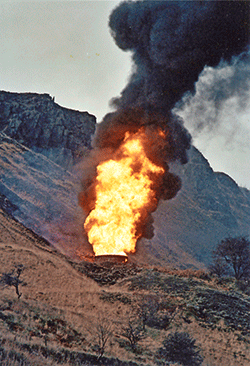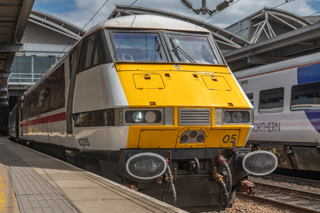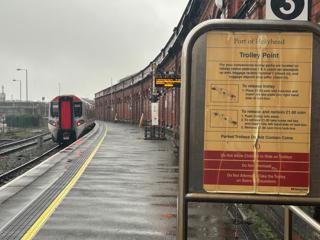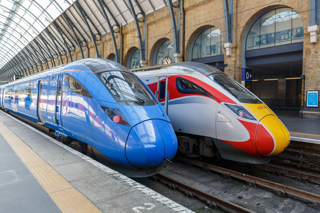At 1005 on December 20 1984, a major incident was declared by emergency services called out to tackle a fierce blaze deep within Summit Tunnel on the Calder Valley route between Manchester and Leeds.
The derailment of a freight train barely four hours earlier had resulted in the ignition of almost all its cargo of one million litres of petrol.
The fire would take four days to burn itself out as temperatures inside the bore rose well above 1,500 degrees Celsius - hot enough to melt brickwork, steel and weld tanker wagons to the rails. Above ground, assembled news crews, firefighters and local residents were confronted with the apocalyptic scene of 40m high pillars of flames escaping through ventilation shafts dotted about the rural Pennine hillside.
That the tunnel was repairable and could be re-opened just eight months later owed much to the containment efforts of the Greater Manchester and West Yorkshire fire services, but primarily it was to the lasting credit of the structure’s Victorian designers and builders, who toiled underground over 140 years earlier.
Opened on March 1 1841, the completion of Summit Tunnel overcame the final construction hurdle on the UK’s first trans-Pennine route: the Manchester & Leeds Railway. At 60 miles long, it was never going to be the shortest or quickest route between the two cities which are a mere 35 miles apart in a direct line, but the alignment was chosen to avoid steep inclines and use the existing tracks of the North Midland Railway from Normanton for the final ten miles into Leeds. Today’s northernmost trans-Pennine route to Leeds via Halifax and Bradford opened 13 years later in 1854.
Summit Tunnel is 15 miles north east of Manchester at the county boundary between Greater Manchester and West Yorkshire on a section of the line running roughly north to south between Littleborough and Walsden before the route turns to the east towards Hebden Bridge, Brighouse, Wakefield and Normanton Junction.
As its name suggests, the double-track tunnel is at the summit of the line with a rising gradient of 1-in-330 from Littleborough towards the tunnel’s northern portal, followed by a 1-in-182 falling gradient to Walsden. Cut through shale, gritstone, coal measures and broken ground, its brick lining varies in depth between five to ten rows throughout, with 14 ventilation shafts dug at intervals into the hillside above.
At 2,885 yards long, it was the longest railway tunnel in the world on completion but it would only hold this record until 1845 and the opening of the three mile-long Woodhead Tunnel linking Manchester and Sheffield.
The project’s famous chief engineer George Stephenson and his tunnel engineer Barnard Dickinson would face myriad geological challenges and difficulty penetrating the hard rock, driving the eventual cost to £251,000 – comfortably exceeding the tender price of £107,800 – and claiming the lives of 28 workers through accidents. Having laid the first brick in August 1838, the slow pace of construction would lead to change of contractors in March 1839 while labour disputes would result in 16 workers being brought before Magistrates in February 1841 for intimidating workmen in receipt of higher wages.
Delays to the tunnel forced the line to open in sections: Manchester to Littleborough in July 1839, Normanton to Walsden in December 1840 and the entire through route three months later.
When the last brick was laid in December 1840, Dickinson proudly boasted that the tunnel would defy “the rage of tempest, fire or war or wasting age”.
It was during that same month 144 years later that his words would be put to their sternest test in one of the most ferocious underground fires in transport history.
The train involved was the 0138 Haverton Hill (Teesside) to Glazebrook (Merseyside) freight train, consisting of 13 tank wagons containing 835 tonnes of petroleum hauled by Class 47 47125. Heading southwards, it entered Summit Tunnel at 0550 on December 20 1984 along the up line at 40mph. Three quarters of a mile inside the tunnel, the fourth and fifth wagons derailed, severing the air brake pipe and triggering an emergency application of the trains’ brakes.
The subsequent accident report compiled by HM Railway Inspectorate found the cause of the derailment to be a catastrophic failure of the fourth wagon’s leading left axlebox roller bearing. The damage caused to the track by the fractured wheelset caused all the following vehicles to derail and fire to break out quickly as leaking petrol was ignited by a hot axlebox.
Blocked by the spreading fire behind them, the train’s three-man crew ran the remaining mile to the tunnel’s south portal where they were able to advise a signaller at Preston Power Signal Box from a signal post telephone that the train was blocking both tracks, carrying petroleum products and that emergency services were required.
In the rush to flee the burning vehicles and fumes driver Stanley Marshall had no time to place track circuit operating clips on the track to change all signals to danger, but told the accident inquiry that he would have attempted to warn any oncoming trains by waving his lamp. As his train had not yet left the tunnel and still occupied the signalling section its rear was protected by a red light.
The initial call for assistance was received by Greater Manchester Fire Service at 0608, and was relayed to West Yorkshire Fire Service at 0613 so crews could be despatched to both portals. Three pumping appliances and one foam tender were in place at both ends by 0622, sent from Littleborough and Rochdale fire stations.
The first responders were able to enter the tunnel for a distance of one mile from the southern end and 1,000 yards from the northern end to assess the situation. Under supervision, the traincrew were asked to return to the train at 0840 to uncouple the locomotive and three tank wagons located forward of the derailment and drive them to safety, thereby removing 16,000 tonnes of fuel from the reach of the flames.
At this stage, the fire began to develop more rapidly as more wagons caught fire and the rising temperature of the tunnel forced open the pressure release valves of all ten remaining wagons. The vented vapour caught fire, prompting firefighters to rapidly withdraw from the tunnel. Rolling along at roof level, flames began to be vented up the three of the tunnel’s 14 ventilation shafts nearest the train, fortunately allowing firefighters to retreat unharmed. As the fire burned out of control, a major incident was declared at 1005 and the decision taken to introduce high expansion foam down four ventilation shafts to starve the fire of oxygen. There were further problems for firefighters raising water from the Rochdale Canal further down the valley as pumping equipment requiring a flat base could not be easily placed on steep hillsides and embankments.
At the height of the blaze on December 20, the combustion process was so fuel-rich that there was inadequate oxygen inside the tunnel to feed the flames. This caused superheated vapour to explode through the ventilation shafts at over 100mph, reaching 40m into the air. In the biblical scenes above the tunnel, burning projectiles rained onto the hillside, setting fire to vegetation, prompting the evacuation of 170 local residents in Littleborough and Walsden and the closure of the Todmorden to Rochdale A6033 road.
By 0900 on December 21 there were no more visible flames and fire crews re-entered the tunnel to begin tackling isolated fires at track level but reported loud and disconcerting noises as cooling brick, metal and rock began to contract.
The signal was eventually sent that the situation had been brought under control at 1838 on December 24.
British Rail inspectors were granted entry on December 27 to assess the damage, and the Fire Service presence was finally ended on January 03 1985.
Initial site inspections revealed scorched sleepers and vitrified brickwork where the tunnel lining had melted in the heat and flowed as glass-like deposits down the tunnel wall.
Both tracks were distorted, and most of the steel tank wagons had collapsed in on themselves with evidence of melting.
The investigation concluded that the axle failure probably occurred as a result of incorrect assembly and that the wagon concerned had re-entered service only ten days before the accident with reconditioned wheelsets.
As the petrol train had last passed a hot axlebox detector over 70 miles from the accident site to the north of York on the East Coast Main Line, the report concluded that a detector sited on the approach to Summit Tunnel might have averted the accident once an axle failure looked imminent. It therefore called for their installation at more frequent intervals and at strategic places such as long tunnels or bridges where evacuation and fire fighting could prove difficult.
The report also made clear the potential consequences had the train been carrying a nuclear load and not petrol.
In terms of restoration, crucially the tunnel had been built with five to ten rows of bricks around the bore and as only the first three rows had been melted it retained its structural integrity and was quickly established to be repairable.
British Rail’s Preston area civil engineer Stewart Duncan oversaw the work, which could not begin until the charred wreckage of the burned out tankers could be cut into small pieces and removed on small trolleys over a three-month period. Only in March 1985 could a full civil engineering assessment finally be undertaken.
650 yards of new double track was laid and long stretches of new concrete lining were sprayed into the spaces where damaged brick had been removed. The two ventilation shafts immediately above the crash site were steel braced, filled with foam and capped top and bottom with concrete to prevent collapse. Half a mile of telecommunications and signalling cabling was replaced. The full cost of the tunnel’s restoration was estimated to exceed £1 million.
While repairs were completed, rail replacement buses ran between Rochdale and Todmorden while freight was diverted via the Huddersfield and Diggle route. On August 17 1985 Todmorden Rotary Club organised a walk through the tunnel from end to end before the line re-opened for traffic on August 19.
The first passenger service was the 0650 Manchester Victoria-Leeds, and a ceremonial re-opening took place later that morning when a party of local dignitaries and MPs gathered on Todmorden station to watch a Class 142 DMU break through a tape and proceed under a celebratory arch of water, aptly provided by the West Yorkshire Fire Service.
Twenty-six years later, temperatures of a very different kind saw Summit Tunnel back in the news after the derailment of TransPennine Express’s three-car 0038 Manchester Airport-York service caused by ice.
TransPennine Express 185144 was the first train to use the tunnel in over three days due to the Christmas period and at 0123 on December 28 2016 struck a piece of ice weighing between 20 and 25 tonnes while travelling at 57mph.
The impact lifted the wheels of the front bogie into the air, which while still attached to the train returned to ground nine metres further on to the left of the running rails.
None of the other wheels were derailed and the train ran for a further 254 metres with the emergency brakes applied, skirting the tunnel wall in several places.
Knowing the northern portal to be only a quarter of a mile distant and failing to receive a signal on the train’s radio, the driver left the headlights on as a hazard warning and walked to the nearest signal with a telephone.
Track circuit operating clips placed by the guard ensured signals at both tunnel portals were set to danger and emergency services were summoned.
By 0213 all three emergency services and Network Rail mobile operations staff were on site to prepare for the evacuation of 45 passengers who, although unharmed, were sat in fully lit but unheated carriages.
At 0345, just before the evacuation was about to begin, ice fell from a ventilation shaft on to the roof of the second vehicle, leaving passengers shaken.
They then congregated in the leading car.
After removing ice hanging precariously above the evacuation route, firefighters from the West Yorkshire Fire Service completed the evacuation by 0440 and passengers were taken onward by bus from Walsden station.
Later that day the train was re-railed and moved under its own power back to Ardwick Depot running at a maximum speed of 40mph, where repairs were made to its damaged windscreen, coupler and bodywork.
A Network Rail road-rail excavator removed the fallen ice and the tunnel re-opened at 2300 with only minor damage to the track.
The ice block, which had formed in a ventilation shaft during a long period of cold weather before thawing and fouling the line, had not been identified as a risk by NR in the tunnel’s routine maintenance regime. The lack of an inspection before train services resumed after a three-day gap compelled the Rail Accident Investigation Branch to recommend NR put in place measures to check that structures are safe to use after dormant periods, and that cold weather and thaw conditions be taken into account by more robust weather management processes.
Of course, while the tunnel was built to survive the ravages of time, it is unlikely that fire was ever a principal design criterion for Victorian tunnellers.
Petrol was not a major fuel source in 1838 and so the structure’s resilience to fire is almost certainly coincidental rather than intentional.
The ventilation shafts that so fortunately provided an alternative exit point for ignited vapour enabled firefighters to make their escape, but again this was probably more through luck than judgement as their original purpose had become largely redundant following the withdrawal of steam traction.
But lacking the foresight to predict the fiery events of December 1984 makes Barnard Dickinson’s words all the more poignant, and March 1 2016 a very happy birthday indeed for Summit Tunnel.
- This feature was published in RAIL 797 on March 30 2016
















Rich - 20/12/2021 11:24
Amazing story - worthy of a movie adaptation.